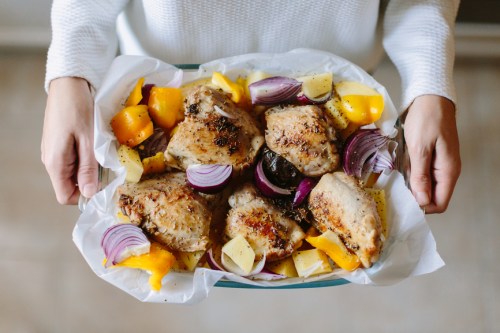Our editors independently select these products. Making a purchase through our links may earn Well+Good a commission
In today’s edition of The Patriarchy Sucks, the United States Department of Agriculture reports that women spend an average of 51 minutes per day cooking and cleaning up after a meal. Men, on the other hand, spend just 22 minutes performing the same tasks.
Of course, spending time preparing a recipe from scratch can be a loving act of self care or other care, but there are days when that time chips away from otherwise enjoying your life. When that’s the case, we curated the best time-saving kitchen tips from our stable of nutrition efforts. You deserve to have those 29 extra minutes for doing you—not the dishes.
The best time-saving kitchen tips for cutting meal preparation in half
1. Pack your cooking repertoire with one-pot recipes and semi-homemade meals
A sink full of crusty pans, dishes, and silverware can mean spending 20 more minutes in the kitchen that you could fill with Netflix, a run in the park, or literally anything else. That’s why one-pot recipes, like this linguine, or semi-homemade dinners that combine premade with fresh foods, can be such a game-changer. At the end of the meal, you just have to clean a plate, a fork, and a pot. That’s a wrap.
2. Get down with a sheet pan full of veggies
Cooking everything on the stovetop requires your constant attention. (Is it burning? Am I stirring enough?) Body Love Everyday author and celebrity nutritionist Kelly Leveque‘s sheet pan veggies ask you to chop and spice your produce of choice, pop them in the oven at 350 degrees, then go about your business for 20 to 30 minutes. Even better: If you use parchment paper or baking mats (this $14 set is my favorite), there won’t be a pan to scrub in sight.
These are the fruits and veggies to prioritize buying organic, if available to you:
3. Invest in the kitchen gadgets that make the most sense for your lifestyle
Let’s face it: There a difference between kitchen gadgets that are useful (oh, how I love you, air fryer) and kitchen instruments that quickly become junk (ahem, that zoodler attachment). Investing in something like a high-quality chef’s knife or an electric food processor can cut you chopping time way, way down so that you can have fresh-cut veggies without too much fuss.
4. Don’t buy all your veggies fresh. Make use of canned and frozen ones, too
The idea that fresh vegetables are somehow better than frozen has long been debunked. Bonus: Since frozen produce is often pre-cut, you can save yourself a lot of time (and money) by shopping for a large part of your nutrients in the frozen aisle.
As for the canned goods, Casey Means, MD, a practicing physician specializing in nutrition and disease prevention, previously told Well+Good that she just can’t get enough canned tomatoes, hearts of palm, and artichoke hearts—so don’t feel like you have to empty your wallet (and sacrifice your time) to room-temp vegetables.
5. Take advantage of salad bars to cut down prep time
On the premiere episode of Well+Good’s YouTube series Cook With Us, celebrity chef Dale Talde blew my mind with the simple yet genius suggestion to use the pre-made food at your local grocery stores as part of your cooking process. “It’s using really nice salad bars as your mise en place,” he says. “They did all the work for you.” For example, if you were whipping up a stir-fry, you can hit the salad bar to get pre-chopped onions, a handful of bean sprouts, shredded carrots, and toss all of it into your wok without even dirtying a knife.
Make a stir-fry in a flash with the help of Chef Talde:
There are a lot of spices out there, but these are the only seven you need. Plus, why you should freezer (yes, freeze!) your nutmeg before storing it in your pantry.
Sign Up for Our Daily Newsletter
Get all the latest in wellness, trends, food, fitness, beauty, and more delivered right to your inbox.
Got it, you've been added to our email list.











